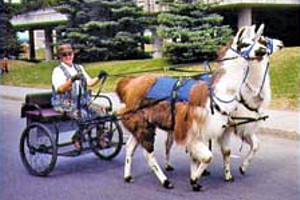About Llamas: Llama Uses
Llamas have several other uses other than being fine fibre producers. These include driving or carting, guarding, hiking/packing and as therapy animals.
Driving and Carting

Llama enthusiasts who have taken the time to train their llamas to drive a cart are finding that driving a llama can be most enjoyable. It is probably the most difficult of the skills asked of a llama but also one of the most rewarding and fun when it has been accomplished.
The harness and cart should be especially designed for the llamas as the llamas stride is significantly longer than that of a pony. There are several harness designs available with some being similar to a horse or pony harness. Driving has many uses: the show ring, for personal recreation and for work related activities ie: hauling wood, cleaning barns, etc. Conditioned, well-built driving llamas can trot for miles. Even a less-well-endowed llama with good equipment, proper conditioning and proper work practices can take you for a pleasurable drive for several kilometres.
Like all things, driving is not for everyone or every llama. Some aspects like equipment transporting can't be done alone. Some locations just don't have a decent area to drive within a reasonable distance. Some llamas simply don't like the effort involved, are too herd-bound for use as pleasure-driving animal, or are too unpredictable to be safe in a harness. Some llamas are physically unsuitable and can incur serious damage from driving.
Before embarking on a "driving adventure" we recommend spending a day or two with an experienced driving handler and team. With proper training for both you and your llama, driving and carting can be a wonderfully relaxing and enjoyable experience, never mind the incredible bond you can build between you and your llama.
Guarding
Guard llamas are found across North America today as they are easily adaptable to any terrain and climate. Llamas are naturally aggressive to members of the canid family (coyotes, foxes, dogs) and will defend their territory vigorously with typical responses being alert attention, alarm calls, and challenges that can include kicking or pawing and charging the offender.
This natural aggression means that a llama does not need to be "trained" to guard. Once introduced to a flock of sheep and after an initial adjustment period for all parties (llama and sheep) the llama will adopt the sheep as it's flock and naturally defend them. Studies have shown that in over 80% of the cases where a guard llama was present their predation control was "effective" to "very effective".
Family dogs must be carefully introduced to a guard llama so that the llama does not see the dog as a threat and try to hurt it.
It is also important to note that more than one llama does not increase the protection rate and in fact, may work the opposite. Two or more llamas in with the herd will tend to stick to themselves, while one llama "adopts" the herd as its own. Also, for some reason not every llama makes a good guard llama. Its is important to ask the current owner whether they have witnessed such behaviour in any potential llama you may be thinking of buying for that purpose.
Camping, Hiking and Packing
This is one of the greatest venues to truly discover how wonderful llamas are.
Many people use their llamas for packing. Because of their easy-going nature and their low impact on the environment, old and young can enjoy wilderness treks they would not encounter with other pack animals. Backpacking with tents and gear is sometimes more a workout than it is enjoyable but with a llama packing the goods one can relax and simply enjoy the outdoors. Many people enjoy the one-on-one relationship they develop with their llama.
The most notable advantage of using llamas as packers is their low environmental impact. Their soft padded feet may actually damage the trail less then the average hiker. They are much smaller then most equine pack stock with the average pack llama weighing 250 and 350 pounds and can carry about 1/3 of their weight. Llamas are natural browsers, meaning that as they graze they are taking a bit here and there leaving little trace of their passing.
Therapy
Llamas bring a sensation of tranquility and peace to children, physically and mentally handicapped youth and adults, overstressed workers, the old and infirm, and the terminally ill. Llamas excel as public relations ambassadors t nursing homes and hospitals, and bring a sense of wonder that an animal can actually make a difference in the outlook and well-being of the patients. Patients look forward to the days that the llamas come to visit.
There is something about the gentle inquisitiveness of a llama that calms, refreshes and reassures us when we are feeling "stressed out" or not feeling well. A llama can often display a caring and loving attitude towards humans. The right llama, calm and caring, can make a human face light up by bestowing a small and gentle "llama kiss".
